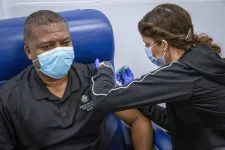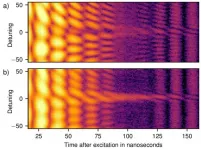(Press-News.org) The first global-scale assessment of the role ecosystems play in providing sanitation finds that nature provides at least 18% of sanitation services in 48 cities worldwide, according to researchers in the United Kingdom and India. The study, published February 19 in the journal One Earth, estimates that more than 2 million cubic meters of the cities' human waste is processed each year without engineered infrastructure. This includes pit latrine waste that gradually filters through the soil--a natural process that cleans it before it reaches groundwater.
"Nature can, and does, take the role of sanitation infrastructure," said Alison Parker, a Senior Lecturer in International Water and Sanitation at Cranfield University in the United Kingdom and one of the authors of the study. "While we are not marginalizing the vital role of engineered infrastructure, we believe a better understanding of how engineered and natural infrastructure interact may allow adaptive design and management, reducing costs, and improving effectiveness and sustainability, and safeguard the continued existence of these areas of land."
Wastewater treatment infrastructure that converts human feces into harmless products is an important tool for global human health. However, more than 25% of the world's population did not have access to basic sanitation facilities in 2017 and another 14% used toilets in which waste was disposed of onsite. While some of this waste may be hazardous to local populations, previous research has suggested that natural wetlands and mangroves, for example, provide effective treatment services. The Navikubo wetland in Uganda processes untreated wastewater from more than 100,000 households, protecting the Murchison Bay and Lake Victoria from harmful contaminants, while in the United States coastal wetlands in the Gulf of Mexico remove nitrogen from the Mississippi River.
"We realized that nature must be providing sanitation services, because so many people in the world do not have access to engineered infrastructure like sewers," adds Simon Willcock, a Senior Lecturer in Environmental Geography in Bangor University, UK, and another author of the study. "But the role for nature was largely unrecognized."
To better understand how natural ecosystems process waste, the team from Bangor University, Cranfield University, Durham University, University of Gloucestershire, University of Hyderabad (India) and the Fresh Water Action Network, South Asia quantified sanitation ecosystem services in 48 cities containing about 82 million people using Excreta Flow Diagrams, which leverage a combination of in-person interviews, informal and formal observations, and direct field measurements to document how human fecal matter flows through a city or town. The researchers assessed all diagrams that were available on December 17th, 2018, focusing on those coded as "fecal sludge contained not emptied" (FSCNE), in which the waste is contained in a pit latrine or septic tank below ground but does not pose a risk to groundwater, for example, because the water table is too deep.
Conservatively, Willcock and colleagues estimate that nature processes 2.2 million cubic meters of human waste per year within these 48 cities. Since more than 892 million people worldwide use similar onsite disposal toilet facilities, they further estimate that nature sanitizes about 41.7 million tons of human waste per year before the liquid enters the groundwater--a service worth about $4.4 billion per year. However, the authors note that these estimates likely undervalue the true worth of sanitation ecosystem services, since natural processes may contribute to other forms of wastewater processing, though these are harder to quantify.
Willcock and colleagues hope that their findings will shed light on an important but often unrecognized contribution that nature makes to many people's everyday lives, inspiring the protection of ecosystems such as wetlands that protect downstream communities from wastewater pollutants.
"We would like to promote a better collaboration between ecologists, sanitation practitioners and city planners to help nature and infrastructure work better in harmony, and to protect nature where it is providing sanitation services," said Parker.
INFORMATION:
This work was prepared as part of the ESRC and ICSSR funded Rurality as a vehicle for Urban Sanitation Transformation (RUST) project.
One Earth, Willcock et al.: "Nature provides valuable sanitation services"
https://www.cell.com/one-earth/fulltext/S2590-3322(21)00049-X
One Earth (@OneEarth_CP), published by Cell Press, is a monthly journal that features papers from the fields of natural, social, and applied sciences. One Earth is the home for high-quality research that seeks to understand and address today's environmental Grand Challenges, publishing across the spectrum of environmental change and sustainability science. A sister journal to Cell, Chem, and Joule, One Earth aspires to break down barriers between disciplines and stimulate the cross-pollination of ideas with a platform that unites communities, fosters dialogue, and encourages transformative research. Visit http://www.cell.com/one-earth.
To receive Cell Press media alerts, contact press@cell.com.
SEATTLE -- February 19, 2021 -- A team of scientific experts from across the U.S. and Puerto Rico are advocating for increased diversity in vaccine trials after publishing a new report that highlights a decade's worth of disparities. The new study, published in JAMA Network Open, found that among U.S.-based vaccine clinical trials, people who are Black/African American, American Indian/Alaska Native, Hispanic/Latino and age 65 and older were the most underrepresented groups. Conversely, adult women were overrepresented.
The research team examined 230 U.S.-based vaccine trials of all ...
What The Study Did: Persistent symptoms among adults with COVID-19 up to nine months after illness onset were analyzed in this study.
Authors: Helen Y. Chu, M.D., M.P.H., of the University of Washington in Seattle, is the corresponding author.
To access the embargoed study: Visit our For The Media website at this link https://media.jamanetwork.com/
(doi:10.1001/jamanetworkopen.2021.0830)
Editor's Note: The article includes conflict of interest and funding/support disclosures. Please see the article for additional information, including other authors, author contributions and affiliations, conflict of interest and financial disclosures, and funding and support.
INFORMATION:
Media advisory: The full study is linked to this news release.
Embed ...
What The Study Did: This survey study compared patterns of mental health concerns, substance use and suicidal ideation during June and September of the COVID-19 pandemic and examined at-risk demographic groups.
Authors: Mark É. Czeisler, A.B., Monash University in Clayton, Victoria, Australia, is the corresponding author.
To access the embargoed study: Visit our For The Media website at this link https://media.jamanetwork.com/
(doi:10.1001/jamanetworkopen.2020.37665)
Editor's Note: The article includes conflicts of interest and funding/support disclosures. Please see the article for additional information, including other authors, author ...
What The Study Did: Using data from completed interventional vaccine trials from 2011 to 2020, researchers examined whether racial/ethnic minority groups, females and older adults were underrepresented in U.S.-based vaccine clinical trials.
Authors: Steven A. Pergam, M.D., M.P.H., of the Fred Hutchinson Cancer Research Center in Seattle, and Julie K. Silver, M.D., of Harvard Medical School in Boston, are the corresponding authors.
To access the embargoed study: Visit our For The Media website at this link https://media.jamanetwork.com/
(doi:10.1001/jamanetworkopen.2020.37640)
Editor's Note: The article includes conflicts of interest disclosures. Please see the article for additional information, including other authors, author contributions ...
Women of minority races and ethnicities and with less education and income have had relatively lower access to 3D mammography, a technology that can improve breast cancer detection and decrease false alarms, according to research published today.
"This study was about whether adoption of this technology is equitable. We're showing that it has not been, even though it has been FDA-approved for a decade now," said END ...
Recreational hunting -- especially hunting of charismatic species for their trophies --raises ethical and moral concerns. Yet recreational hunting is frequently suggested as a way to conserve nature and support local people's livelihoods.
In a new article published in the journal One Earth, scientists from the University of Helsinki in Finland and Flinders University in Australia have reviewed more than 1,000 studies on recreational hunting -- the first such attempt to summarize the scientific literature examining the biodiversity and social effects of recreational hunting globally.
Co-lead author University of Helsinki Associate Professor Enrico ...
Creating "super soldiers" of specific white blood cells to boost an anti-tumour response has been shown in a series of elegant experiments by Princess Margaret researchers.
Research led by Ph.D. candidate Helen Loo Yau, Post-doctoral fellow Dr. Emma Bell and Senior Scientist Dr. Daniel D. De Carvalho describes a DNA modifying epigenetic therapy that can transform immune killer T-cells into "super soldiers" by boosting their ability to kill cancer cells.
Their findings could potentially enhance immunotherapy, a new paradigm in cancer treatment currently effective for a minority of cancer patients. Some patients respond well to immunotherapy, with their tumours drastically shrinking in size, but others respond only partially or not at all. Clinicians and scientists around ...
At some point, microvehicles that are small enough to navigate our blood vessels will enable physicians to take biopsies, insert stents and deliver drugs with precision to sites that are difficult to reach, all from inside the body. Scientists around the world are currently researching and developing suitable microvehicles. In most cases, they are powered and controlled by acoustic and magnetic fields or using light. However, until now, propelling microvehicles against a fluid flow had proved to be a major challenge. This would be necessary for the micromachines to be able to navigate in blood vessels against the direction of blood flow. Researchers at ETH Zurich have now developed microvehicles ...
The latest observations from Insight-HXMT were published online in Nature Astronomy on Feb. 18. Insight-HXMT has discovered the very first X-ray burst associated with a fast radio burst (FRB) and has identified that it originated from soft-gamma repeater (SGR) J1935+2154, which is a magnetar in our Milky Way.
Insight-HXMT is the first to identify the double-spike structure of this X-ray burst as the high energy counterpart of FRB 200428. This discovery, together with results from other telescopes, proves that FRBs can come from magnetar bursts, thus resolving ...
From atomic clocks to secure communication to quantum computers: these developments are based on the increasingly better control of the quantum behaviour of electrons in atomic shells with the help of laser light. Now, for the first time, physicists at the Max Planck Institute for Nuclear Physics in Heidelberg have succeeded in precisely controlling quantum jumps in atomic nuclei using X-ray light. Compared with electron systems, nuclear quantum jumps are extreme - with energies up to millions of times higher and incredibly short zeptosecond processes. A zeptosecond is one trillionth of a billionth of a second. The rewards include profound insight into the quantum world, ultra-precise nuclear clocks, ...




